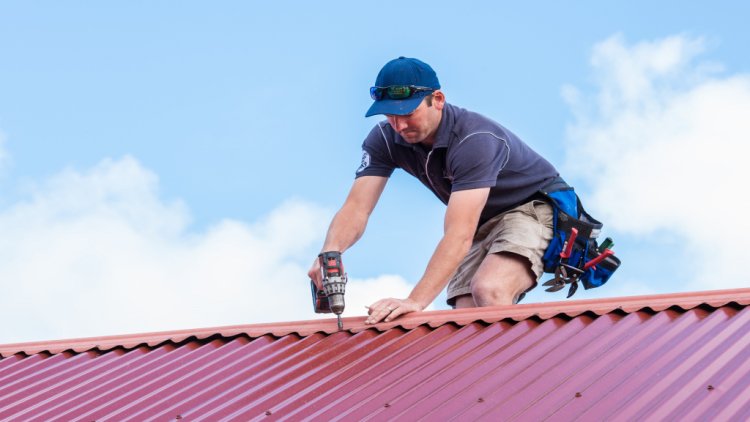How Spring Weather Impacts Your Roof: Tips for Seasonal Maintenance
Learn how spring weather affects your roof and discover expert tips for seasonal maintenance. Protect your home from leaks, debris, and weather-related damage this season.

Spring is a beautiful season, bringing with it warmer weather, blooming flowers, and longer days. However, it also brings some challenges for homeowners, especially when it comes to maintaining your roof. Winter’s toll may have left behind damage, and springtime’s unpredictable weather – heavy rain, high winds, and fluctuating temperatures – can accelerate any existing issues. To protect your home, you need to stay on top of roof maintenance and repair. Here's how spring weather impacts your roof and what you can do to keep it in top shape.
The Impact of Spring Weather on Your Roof
1. Heavy Rain and Roof Leaks
Spring is notorious for its heavy rain showers, and with rainfall comes an increased risk of leaks. When your roof has minor wear, these rains can worsen issues and penetrate your roof. Clogged gutters can also lead to water buildup, causing damage to the shingles, roof underlayment, and structural components of your roof.
2. High Winds
Windstorms are common during spring, and these high winds can cause significant roof damage. When gusts reach high speeds, they can lift shingles or even tear them off entirely. A missing or damaged shingle leaves your roof vulnerable to leaks and other damage. If left untreated, wind-damaged areas can exacerbate existing roof damage.
3. Temperature Fluctuations
Spring is a season of transitions, meaning that your roof will likely experience fluctuating temperatures from chilly mornings to warmer afternoons. This drastic temperature shift can cause the materials in your roof to expand and contract, which may lead to cracking or deterioration of the materials. Shingles, flashing, and sealants may wear out due to these changes, reducing the roof’s effectiveness at keeping water out.
4. Pollen and Debris
In the spring, pollen, leaves, and other debris fall from the trees. This natural buildup on your roof can be more than just unsightly. Debris like this can clog up your gutters and prevent water from draining properly. When water doesn't drain, it can back up into the shingles, which is a prime recipe for leaks and damage to the roofing system.
5. UV Exposure
Springtime also increases the amount of sunlight your roof is exposed to. Though not as intense as the summer sun, prolonged exposure to ultraviolet (UV) rays can degrade roofing materials over time. UV rays cause roofing components like shingles, underlayment, and sealants to become brittle, decreasing their effectiveness. UV radiation also exacerbates the effects of weathering on the roof.
6. Mildew and Moss Growth
During the wet and damp spring months, moss, algae, and mildew can begin to grow on your roof. These organisms can thrive in the presence of moisture and warmth, leading to the development of unsightly stains and, over time, contributing to the deterioration of your roof’s integrity. Especially for those in more humid environments, roof damage can be a bigger concern with mildew or moss infestations, as these growths can trap moisture against your shingles.
Tips for Spring Roof Maintenance to Prevent Damage
While you can’t control the weather, you can take steps to ensure your roof is as protected as possible against the forces of spring. These seasonal roof maintenance tips will help reduce the risk of damage, keep your roof working as intended, and ultimately save you money on repairs.
1. Inspect Your Roof
Start by thoroughly inspecting your roof for any visible signs of damage. You should do this in early spring when the snow is gone, but before the heavy spring rains begin. Look for cracked, curled, or missing shingles, as these are early indicators that your roof may need repair. Also, check your attic for any water stains or signs of leaks that could indicate a hidden issue.
While you can inspect your roof yourself, it’s often best to hire a professional roofer to perform a comprehensive assessment. They have the experience and safety equipment to catch any potential problems that are too subtle for an untrained eye.
2. Clean Out Your Gutters
Clogged gutters are one of the main culprits when it comes to spring roof damage. Debris, like fallen leaves and twigs, accumulates during the winter months, and when the spring rains hit, this debris can cause blockages. Clogged gutters lead to water backing up, which can result in water spilling over the edge, leading to rot and leaks in your roof.
Take the time to clean out your gutters, making sure they are clear of debris and debris-laden standing water. If you don’t feel comfortable getting up on a ladder, hire a professional who can also assess the condition of your gutters while they’re cleaning them.
3. Trim Back Overhanging Trees
Spring is a time when trees begin to grow new leaves and limbs. If you have trees near your roof, now is the time to trim them back to prevent branches from rubbing against your roof or causing any tree-related roof damage. Wind can break off limbs or make them fall on your roof, resulting in dents, punctures, and cracked shingles.
Regularly trimming branches and keeping foliage at bay is not just good for your roof’s protection, but also reduces the risk of fire hazards.
4. Look for Moss and Algae
While moss and algae add charm to certain parts of your yard, they can be harmful to your roof. These organisms trap moisture and cause the shingles to break down, which leads to leaks and further roof damage down the line. Using a roof cleaner designed to remove moss and algae can extend the life of your shingles.
If you're not comfortable using a cleaner yourself, a roofing professional can do this for you safely. Ensure that you use products that are specifically formulated for your roof’s material to avoid causing any damage in the process.
5. Address Damaged Roof Components Promptly
Whether your roof sustained minor or major damage during the winter, make sure you address any problems before they escalate. Replacing or repairing cracked shingles or seals before the heavy spring rains arrive ensures that your roof can withstand the upcoming weather.
By addressing small problems before they turn into major repairs, you’ll not only protect your home, but you’ll save yourself from larger repair bills in the future.
6. Seal Gaps and Leaks
Over time, the seals around vents, skylights, and chimneys may begin to break down or peel off. These seals help prevent leaks when rain or snow hits, so you want to ensure that these areas are sealed properly. A simple re-seal can restore the waterproof nature of these parts and protect your home from potential damage caused by rainwater.
It’s always a good idea to have a roofing professional inspect and reseal areas where the seals have deteriorated, preventing unwanted water infiltration.
7. Protect with Roof Coatings
A roof coating can serve as a protective layer that shields your roof from UV rays, as well as help guard against the growth of moss, algae, and mildew. It also prevents water from seeping into your shingles or roofing system. A professional can apply the right type of coating to protect your roof’s longevity and keep the spring elements from doing any damage.
FAQs About Spring Roof Maintenance
Q: How often should I have my roof inspected?
A: It’s a good idea to have your roof inspected at least twice a year — once in the spring to check for winter-related damage and again in the fall to ensure your roof is ready for the harsher winter months. However, if you notice any unusual signs of roof damage, such as leaks, sagging, or loose shingles, you should call a professional for an inspection.
Q: Can I repair minor roof damage myself?
A: While some minor roof damage can be addressed by homeowners, like replacing a few missing shingles, it's generally safer and more effective to hire a professional roofer. Roofing is hazardous, and any missteps can lead to bigger problems later on. A professional will make sure repairs are completed properly, protecting your home and roof.
Q: Will spring storms damage my roof?
A: Spring storms, with their heavy rain, high winds, and occasional hail, can be very damaging to a roof if it's not in good condition. Be sure to inspect your roof regularly and maintain it to avoid unexpected roof damage when storms hit. In particular, make sure shingles are secure, gutters are clear, and seals are intact.
Conclusion
Spring weather can take a toll on your roof, but with the right proactive maintenance, you can prevent roof damage and ensure your home is safe and protected. Whether it’s cleaning out your gutters, trimming back trees, or addressing roof damage, staying on top of maintenance tasks can save you from costly repairs later on. Regular inspections, addressing issues early, and caring for your roof can go a long way in maintaining the integrity of your home, leaving you with peace of mind as the seasons change.
Be proactive this spring and take the necessary steps to ensure your roof is ready for whatever the season brings!
What's Your Reaction?

















